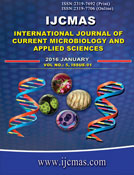


 National Academy of Agricultural Sciences (NAAS)
National Academy of Agricultural Sciences (NAAS)

|
PRINT ISSN : 2319-7692
Online ISSN : 2319-7706 Issues : 12 per year Publisher : Excellent Publishers Email : editorijcmas@gmail.com / submit@ijcmas.com Editor-in-chief: Dr.M.Prakash Index Copernicus ICV 2018: 95.39 NAAS RATING 2020: 5.38 |
The genus Liquidambar L. is the best-known genus of the Altingiaceae Horan family, and species of this genus have long been used for the treatment of various diseases. Liquidambar styraciflua L., which is popularly known as sweet gum or alligator tree, is an aromatic deciduous tree with leaves with 5-7 acute lobes and branched stems. In the present study, we investigated the antimicrobial and antioxidant activity of aerial parts of L.styraciflua. Antimicrobial activity was evaluated using the microdilution methodology. The DPPH and phosphomolybdenum methods were used to assess the antioxidant capacity of the samples. The extracts showed moderate or weak antimicrobial activity. The essential oil had the lowest MIC values and exhibited bactericidal action against Escherichia coli, Enterobacter aerogenes and Staphylococcus aureus. The ethyl acetate fraction and the butanol fraction from the bark and stem showed the best antioxidant activity. This study revealed that the essential oil of L. styraciflua leaves displays antimicrobial activity and can be used as an alternative against pathogenic microorganisms. The extracts and fractions of this species have a high antioxidant capacity, revealing new sources of antioxidants for the food and pharmaceutical industries.
 |
 |
 |
 |
 |